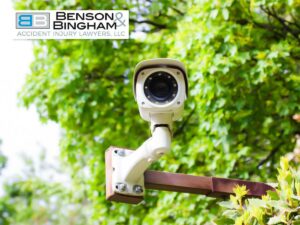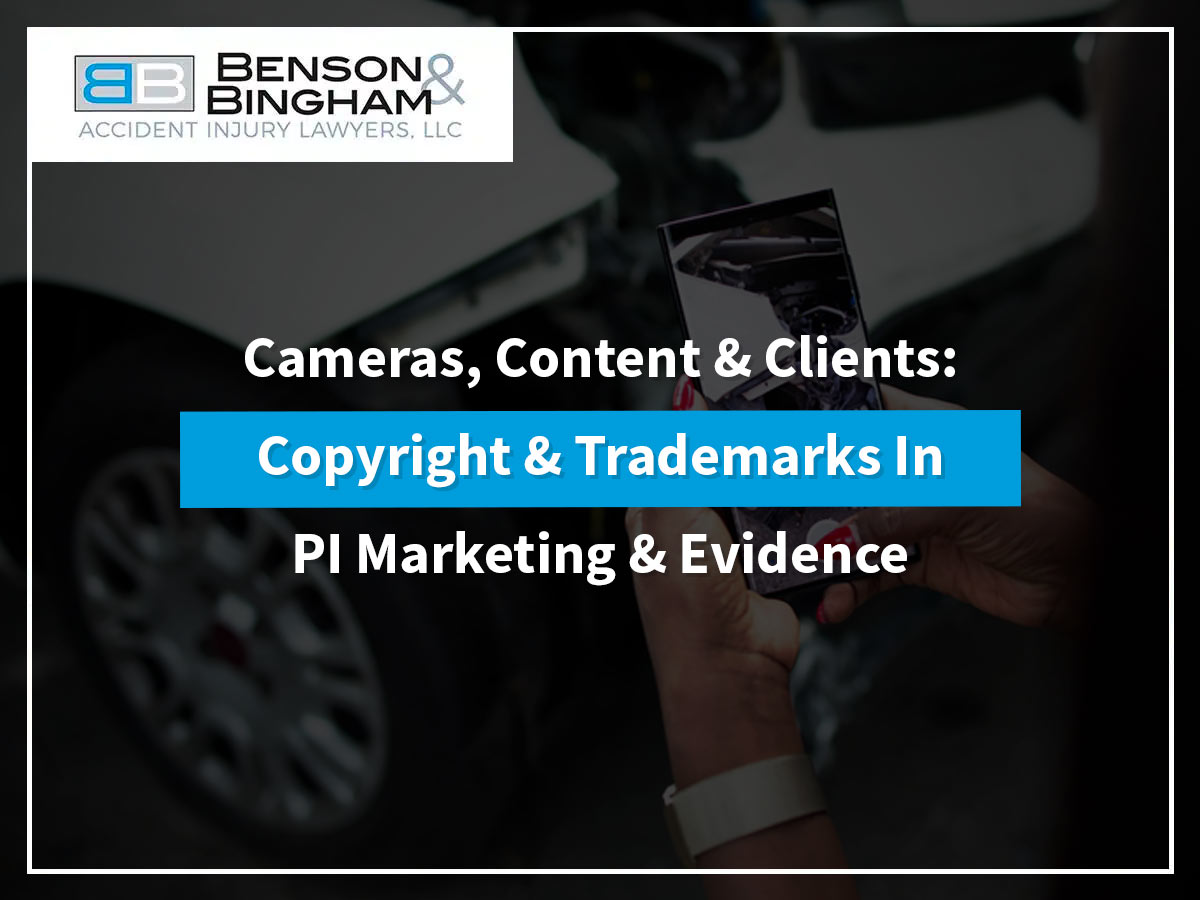Given how innovative our current generation has become, personal injury cases unfold not just inside a courtroom but all across the internet. However, using surveillance footage as evidence or uploading and posting a big verdict online can get you in trouble and raises potential copyright and trademark issues.
Consulting with an Intellectual Property Lawyer can help Personal Injury Firms navigate the intersection of Intellectual Property Law and Marketing Compliance. Below are ways on how to utilize content in building trusts, attract clients, and win cases.
1. Surveillance & Bystander Videos In PI Cases: Copyright Ownership & Fair Use
Copyright Ownership

- Surveillance footage: owned by the business or property owner who recorded it.
- Body-cam recordings: controlled and owned by the government agency or police department.
- Bystander recorded video: automatically owned by the person filming and not the subjects captured in the video.
In situations where a footage is shown to you by your client, copyright ownership stays with the creator. Unless a subpoena was released, public records request, or explicit license, violation of copyright law may occur for using content without permission.
Limitations Of Fair Use
Lawyers would assume that when a footage or clip is used for legal purposes or case updates considered to be “fair use.” That’s risky. While evidence presented in court may be covered, using or repurposing the same footage for personal injury marketing or posting it on social media for promotion is not.
Courts evaluating fair use will consider purpose, amount used, and market impact. So if your firm’s post can harm the original creator or suggests endorsements, your safest route is to get a written license.
Licensing Risks Of Online Sharing
Videos found online, such as YouTube, TikTok, and or any social media, may have their own respective copyright restrictions. So downloading, reposting, embedding videos/contents can or may expose your firm to infringement claims without following licenses. In order to avoid this, make sure to keep a record of permissions, licenses, terms of usage for every third-party video/content used in your marketing strategy.
2. Law Firm Advertising After Big Verdicts: Trademark Traps and False Endorsement Risks
Do Not Use Hospital Or Insurer Names & Logos
After a victory, personal injury firms often highlight where an injury occurred and which insurer paid for the settlement. However, mentioning hospital logos, insurer names, or branded imagery can escalate trademark concerns, such as:
- False endorsement under Lanham Act (showing your firm is affiliated with the institution).
- Tarnishment or trademark dilution (decreases brand reputation)
Even a tiny logo in a courtroom photo or hashtagging hospital names can lead to legal exposure.
Best Practices For Compliant PI Advertising
- Use descriptive phrases instead of brand names, like “New York Hospital”, or “National Insurance Company”.
- Blur or crop out trademarks in settlement photos or testimonial videos.
- Never use SEO tricks in metatags or hashtags mentioning competitor brand names.
3. Social Media Evidence: Ownership, Preservation & Copyright Challenges
Who Owns Social Media Content In PI Cases?
Social media is filled with footage that can be used as evidence in personal injury cases. Clients may post accident photos, updates, or witness videos. Generally, these contents are owned by the person who created it and not the firm.
To be safe, law firms must secure written consent from clients prior to posting or using their social media content for marketing or legal filings. Never ever assume that a public post equals public domain.
Lawful Preservation Of Digital Evidence
To maintain authenticity of each evidence:
- Utilize forensic or eDiscovery tools to gather and preserve posts.
- Never advise clients to remove or edit their post.
- Preserve metadata for authenticity and admissibility
By implementing proper digital preservation, you are protecting your case as well as demonstrated ethical compliance under ABA guidelines.
Copyright Law Interfering With Evidence

It may seem unfair that some people follow this route to hide bad evidence.
When this happens, your law firm can coordinate with the platform that the video is allowed to use for legal purposes (called fair use) or message a counter-notice under 17 U.S.C. §512(g) to put the content back online.
Working with an Intellectual Property Attorney can help you keep important evidence online and stop others for improper copyright claims.
4. Key Takeaways: Trademark & Copyright Best Practices For Personal Injury Lawyers
- Identify copyright ownership.
- Acquire written consent.
- Avoid trademarked logos and names.
- Properly preserve evidence.
- Seek help from a Trademark Attorney.
Disclaimer: This article was written in association with Cohn Legal, PLLC, a trusted law firm focusing on business law, trademarks, and intellectual property, helping established companies, entrepreneurs, and startups across the country in safeguarding their innovations and brands. Click here to find the office location nearest you.
Summerlin Location
11441 Allerton Park Dr #100
Las Vegas, NV 89135
Phone: 702-684-6900
Fax: 702-382-9798
Henderson Location
9230 S Eastern Ave #155
Las Vegas, NV 89123
Phone: 702-463-2900
Fax: 702-382-9798

Written by Joseph L. Benson II, Esq., Attorney and Managing Partner at Benson & Bingham Accident Injury Lawyers, LLC


